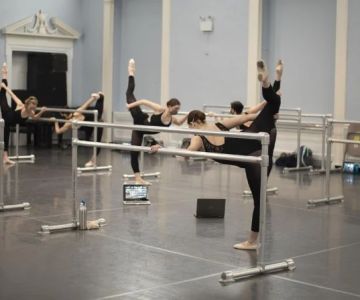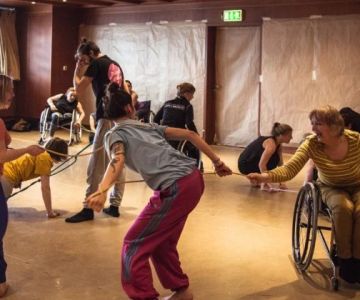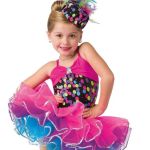
- 1. Why Layering Is Essential for Cold Weather Dance Practice
- 2. Best Materials for Layering in Cold Weather
- 3. How to Properly Layer Clothing for Cold Weather Dance
- 4. Tips for Staying Comfortable and Focused During Practice
- 5. Recommended Dance Gear for Cold Weather
1. Why Layering Is Essential for Cold Weather Dance Practice
When it comes to practicing dance in cold weather, staying warm without sacrificing mobility is key. Layering your clothing is the most effective way to achieve this. Properly layered clothing keeps your body temperature regulated, which is crucial for maintaining flexibility and preventing injury during practice.
In colder months, dance studios or outdoor practice areas can be chilly, making it harder to warm up your muscles. By layering your clothes effectively, you can avoid stiff joints and muscles, allowing you to perform your best even when temperatures drop. Let's explore how to layer effectively for dance practice in cold weather.

Bella Ballerina / bella ballerina leesburg
LeesburgLoudoun CountyVirginia
1053 Edwards Ferry Rd NE, Leesburg, VA 20176, USA
2. Best Materials for Layering in Cold Weather
When layering for cold weather, the material of your clothing plays an important role in regulating temperature, absorbing sweat, and ensuring comfort. Here are some of the best materials to keep in mind:

Crunch Fitness - Frisco / crunch fitness frisco reviews
3865 Preston Rd, Frisco, TX 75034, USA
1. Moisture-Wicking Fabrics
Moisture-wicking fabrics are essential to keeping sweat away from your body. Materials like polyester, nylon, and moisture-wicking blends draw sweat away from your skin, keeping you dry during intense dance movements. These fabrics are also quick-drying, which is perfect for staying warm while practicing.
2. Thermal Layers
Thermal layers, often made from materials like fleece or merino wool, are great for insulation. These materials trap heat while allowing moisture to escape, keeping you warm without overheating. A thin thermal layer is perfect for under your dance clothes to retain body heat.
3. Stretchable Fabrics
As a dancer, flexibility is key, even when layering for warmth. Stretchable fabrics like Lycra, spandex, and elastane allow freedom of movement. These materials are perfect for base layers under your outfit, ensuring you stay comfortable while performing complex movements.
4. Breathable Outer Layers
For the outermost layer, look for jackets or hoodies made from breathable materials like softshell fabrics or breathable fleece. These outer layers should allow your body to breathe while blocking out the cold wind, making them ideal for warm-up sessions or outdoor practices.
3. How to Properly Layer Clothing for Cold Weather Dance
Layering your clothes correctly ensures maximum warmth and mobility. Here's how to layer your clothing for cold weather dance practice:
- Base Layer: Start with a moisture-wicking, breathable base layer. Choose a fitted shirt or leggings that will keep sweat away from your skin without restricting movement.
- Insulation Layer: Add a thermal layer over the base layer, such as a lightweight fleece or thermal tights. This layer should provide insulation without too much bulk.
- Outer Layer: For added protection against wind and cold, top your outfit with a breathable outer layer. A zip-up jacket, dance hoodie, or softshell jacket will keep you warm while allowing you to move freely.
- Optional Accessories: Depending on the temperature, consider adding accessories like gloves, scarves, or a beanie to keep extremities warm. Dance-specific warmers for wrists and ankles can also provide added warmth during practice.
4. Tips for Staying Comfortable and Focused During Practice
While layering is crucial, staying comfortable during your cold-weather dance practice is just as important. Here are some tips to ensure you remain comfortable while focusing on your dance:
- Keep Your Core Warm: Keeping your core warm will help regulate your overall body temperature. A fitted dance jacket or sweater can keep your torso warm while still allowing flexibility.
- Use Breathable Materials: Avoid wearing too many heavy layers that will cause you to overheat once you begin dancing. Instead, focus on breathable, stretchable materials that allow you to move comfortably.
- Start with a Warm-Up: Always warm up before you begin your dance practice. A light warm-up helps increase blood flow, preparing your muscles for movement and keeping your body temperature stable.
- Remove Layers as Needed: If you start to feel too warm, remove a layer to maintain a comfortable body temperature. This will prevent sweating and allow you to focus on your technique.
5. Recommended Dance Gear for Cold Weather
To make your cold weather dance practice even easier, here are some recommended dance gear options:
- Thermal Dance Tights: A must-have for keeping your legs warm during cold weather practice, thermal tights provide insulation without sacrificing flexibility.
- Stretchy Dance Tops: Look for fitted tops made of stretchy fabrics like spandex or Lycra. These materials allow for a full range of motion while keeping you warm.
- Breathable Dance Jackets: Opt for lightweight, breathable jackets with moisture-wicking properties. These jackets will keep you warm without causing overheating.
- Compression Leggings: Compression leggings are perfect for providing support while keeping your muscles warm. They also help reduce soreness after practice.
By layering effectively and choosing the right materials, you can stay comfortable, warm, and focused during your cold weather dance practice. To find the best dance gear for your needs, visit Creative Edge Dance Studio!







 The Studio5.0 (9 reviews)
The Studio5.0 (9 reviews) Fresh Attitude Dance Studio4.0 (10 reviews)
Fresh Attitude Dance Studio4.0 (10 reviews) Conservatory of Music and Dance and The Pennsylvania Performing Arts Company5.0 (2 reviews)
Conservatory of Music and Dance and The Pennsylvania Performing Arts Company5.0 (2 reviews) South Tampa Center for the Arts4.0 (19 reviews)
South Tampa Center for the Arts4.0 (19 reviews) Baltimore School for the Arts5.0 (1 reviews)
Baltimore School for the Arts5.0 (1 reviews) Wanda's Studio5.0 (28 reviews)
Wanda's Studio5.0 (28 reviews) How to Find Free Dance Classes at Community Centers
How to Find Free Dance Classes at Community Centers The History and Evolution of Popular Dance Styles in the US
The History and Evolution of Popular Dance Styles in the US The Best Ways to Learn Dance Choreography Online for Free
The Best Ways to Learn Dance Choreography Online for Free How I Chose My First Costume for a Recital — Mistakes and Wins
How I Chose My First Costume for a Recital — Mistakes and Wins How to Build Endurance for Full-Length Dance Classes | Expert Tips & Strategies
How to Build Endurance for Full-Length Dance Classes | Expert Tips & Strategies How to Travel and Find Dance Classes in Other US Cities: A Dancer’s Guide
How to Travel and Find Dance Classes in Other US Cities: A Dancer’s Guide